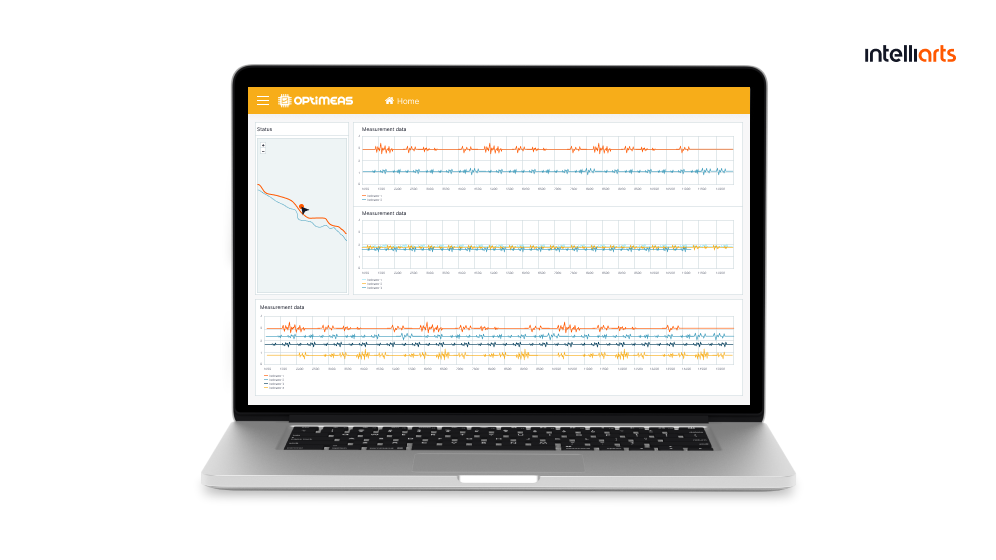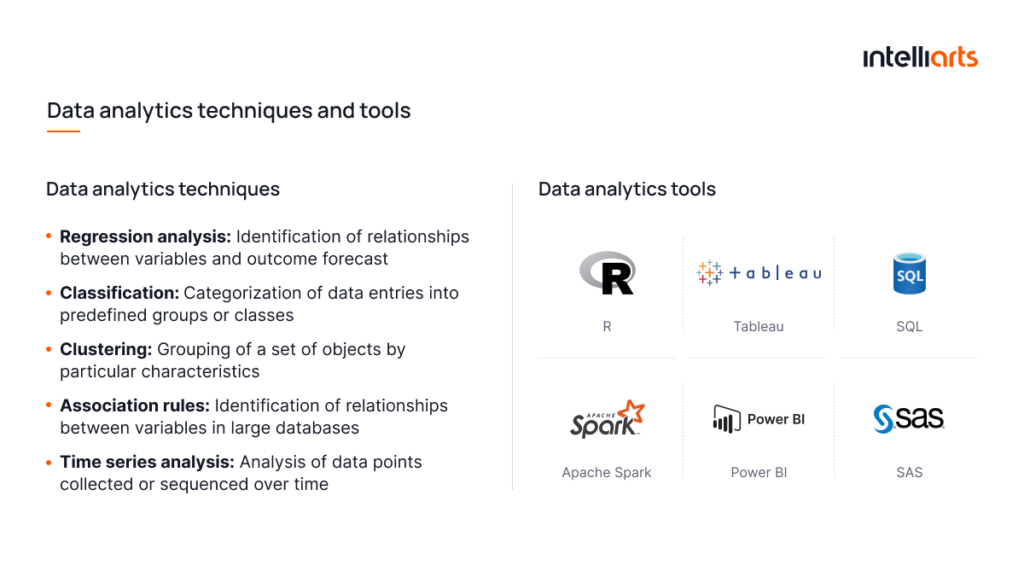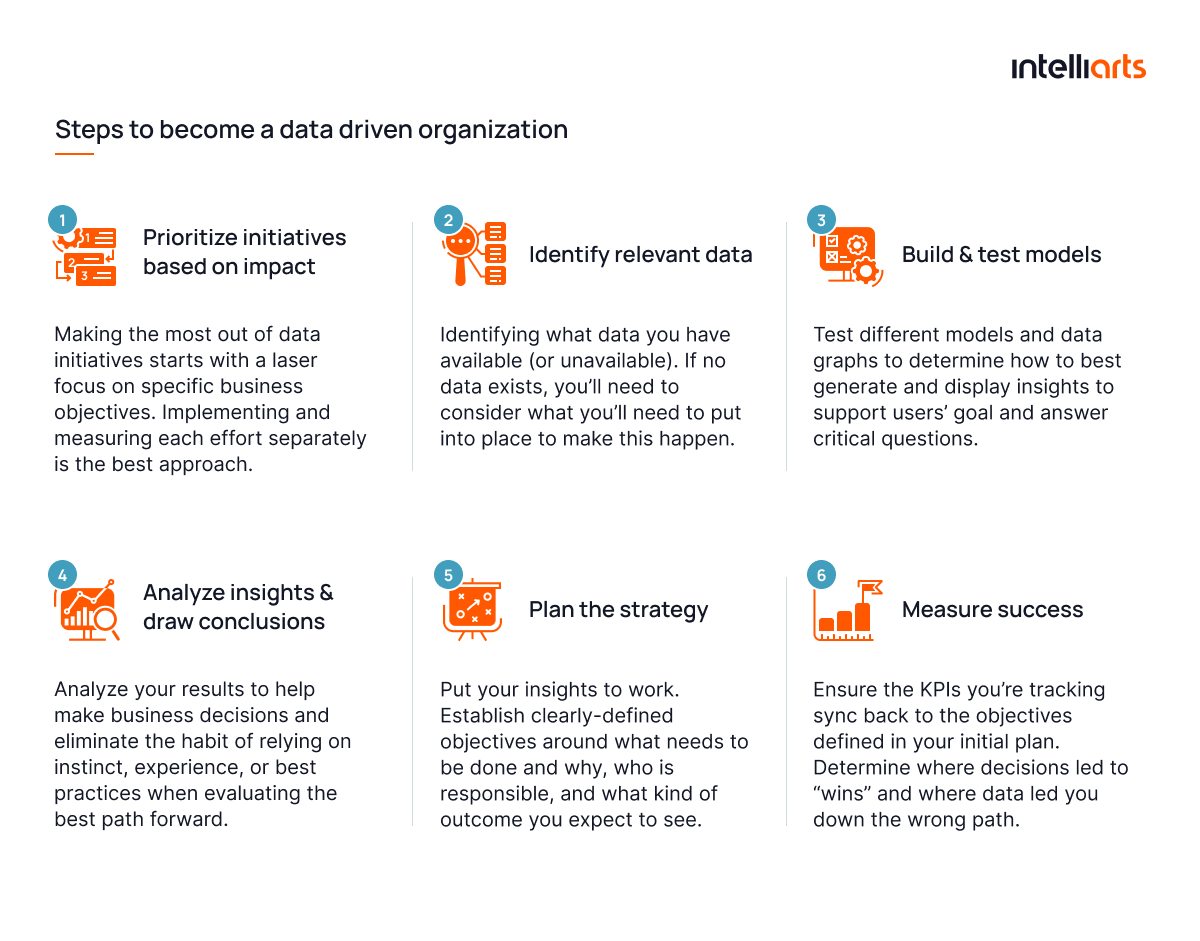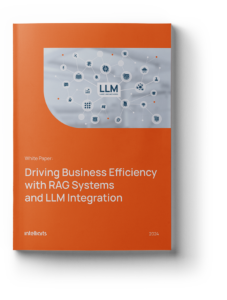Data analysis is increasingly critical in modern business operations. Upon a proper analysis, it can provide more than enough actionable insights to drive decision making, shaping the path toward success in a niche.
The total Business Intelligence market size is projected to reach $59.7 billion by 2025, with larger companies with over 5,000 employees showing adoption rates above 80%. The fastest-growing segment, cloud analytics, is expected to grow from $23.2 billion in 2020 to $65.4 billion by 2025 due to its flexibility and scalability.
In this post, you’ll discover the role of data analytics in business decision making on a high level and the key benefits of using data analysis for business. Besides, you’ll explore challenges in data analytics and solutions to them. We’ll also review list staking, IoT data processing, and improving lead quality cases by Intelliarts.
The role of data analytics in business decision making
First, let’s get to know what is data analysis in business:
Data analytics is the process of examining datasets to uncover patterns, extract insights, and support decision-making.
Data analytics with a simple data visualization instrument or an advanced ML algorithm is just assistance to human analysts who cannot comprehend and interpret thousands of data entries. Basically, the importance of data analytics in business lies in making use of the vast data businesses gather over time in their operations, contacts with customers, observations of the market, competitor research, and more. Data analytics help decision makers to make appropriate decisions that help improve business productivity and get positive growth in the market.
You can discover what data analytics techniques and tools are there from the infographic below:
Looking for consulting services at a trusted data science consulting and engineering firm? Drop the Intelliarts team a line.
Now, let’s get to know what areas of strategic planning and decision-making data analysis in business can contribute to:
#1 Market entry
- Geographic expansion: Companies utilize data analysis to identify potential new markets by evaluating demographic data and consumer behavior.
- Competitive analysis: Data on competitors’ market share and customer reviews can assess the feasibility of entering a market.
Metrics to measure: Market growth rate, customer acquisition cost, price elasticity, Net Promoter Score (NPS)
#2 Product development
- Customer feedback: Data analysis helps refine products by evaluating user feedback.
- Trend analysis: Companies anticipate market needs by studying consumer behavior trends.
Metrics to measure: Customer satisfaction scores, feature usage rates, time on page for product features, adoption rates of new products, and feedback response rates.
#3 Resource allocation
- Budget optimization: Analyzing historical spending helps businesses allocate budgets more effectively, identifying areas for cost reduction or increased investment, as well as determining whether an investor deck may be needed in the near future.
- Operational efficiency: Data from production processes can identify inefficiencies, enabling companies to implement automation measures wisely.
Metrics to measure: Return on investment (ROI), cost savings, budget variance, efficiency ratio, and capital expenditure efficiency.
#4 Risk management
- Predictive analytics: Companies predict risks using data analysis, like financial institutions assessing credit risk through historical loan performance.
- Crisis management: In emergencies, real-time data analysis allows companies to quickly evaluate situations and adapt, such as adjusting supply chains during disruptions.
Metrics to measure: Risk exposure, default rates, predictive accuracy, crisis response time, and impact mitigation effectiveness.
Read also: IoT in Supply Chain
#5 Marketing strategy
- Customer segmentation and targeting: Data analysis can segment customers by purchase behavior and preferences. This helps to tailor marketing efforts.
- Effectiveness of marketing campaigns: Analyzing marketing channel data helps optimize marketing spending by identifying the most effective campaigns.
Metrics to measure: Conversion rates, engagement rates, customer lifetime value (CLV), and marketing ROI.
As we can see, types of data analysis in business, as well as ways to utilize them, are many. At the same time, for many companies, the main issue is how to gather data that powers up data analytics.
You can discover what big data collection is and how it works from another blog post by Intelliarts.
Key benefits of data analysis for business
As explained above, data analysis can be utilized in various forms of business decision making. Here are some of the benefits that data analysis brings to business:
- Cost savings. If approached wisely, data analysis significantly contributes to cost efficiency by identifying areas where expenses can be reduced without compromising on quality or performance. This is crucial for maintaining profitability, especially in highly competitive or low-margin industries.
- Enhanced operational efficiency. By examining data from various business processes, organizations can identify bottlenecks and inefficiencies, leading to streamlined operations and reduced costs.
- Deeper customer understanding. Through data analysis, businesses can gain a profound comprehension of customer preferences, behaviors, and needs. This insight is crucial for effective customer segmentation and targeting in marketing strategies.
- Competitive advantage. Utilizing data analysis helps to understand market dynamics. It also fosters improvement based on consumer insights. This leads to stronger market positioning and the ability to adapt quickly.
- Better innovation and product development capabilities. Data-driven insights highlight emerging trends. This allows companies to define the need for a new product or a feature, this way enhancing product development and lifecycle management.
In truth, it’s difficult to go without data analysis at all. The only question is how properly the processes are established in the company and how much value it can extract from data.
On a basic level, decision-making can overview basic indicators like the number of purchases, percentage of recurring clients, and so on, make assumptions, and create strategy upon it. At the same time, data analysis helps to make sense of even seemingly unusable data and find dependencies in most areas that have been hidden previously.
You may be interested to discover strategies of data science for business in another blog post by Intelliarts.
Challenges in data analytics and how to overcome them
Now, let’s move to the review of common obstacles to setting up solid data analytics processes and what’s possible to do to avoid them:
#1 Data accessibility and integration
Challenge: Seamless access and integration of data across various platforms is often hindered by different data formats, incompatible systems, and data silos, complicating the aggregation and analysis of data.
Solution: Implementing robust data integration tools and adopting standards like APIs can ensure smooth data flow and accessibility, breaking down silos and enabling comprehensive analysis.
#2 Data skills and talent
Challenge: The rapid evolution of data technology outpaces the availability of skilled professionals, limiting a company’s ability to fully leverage data analytics for strategic advantage.
Solution: Investing in training programs and establishing partnerships with educational institutions can build a pipeline of skilled data scientists and enhance the data competency of existing staff.
#3 Data security and privacy
Challenge: With increasing data breaches and stringent regulatory requirements, ensuring data security and compliance is critical for maintaining trust and legal compliance.
Solution: Adopting advanced security technologies, conducting regular security audits, and ensuring adherence to data protection regulations like GDPR can safeguard sensitive information.
#4 Data quality management
Challenge: Inaccurate or poor-quality data can skew analytics, which brings misleading insights and potentially costly business decisions.
Solution: Implementing comprehensive data quality management frameworks and continuous monitoring can maintain high data standards, ensuring that analyses are based on accurate and reliable data.
#5 Cost management
Challenge: Managing the high costs of data storage, processing, and analysis requires efficient resource management, especially as data volumes grow exponentially.
Solution: Leveraging cloud storage and efficient data management practices, such as data deduplication and archival strategies, can significantly reduce costs associated with large-scale data operations.
You can discover more expert insights into data analytics challenges from the video below:
Data analytics in business: Success stories by Intelliarts
Here at Intelliarts, we have substantial experience implementing data analytics solutions to various business needs. Here are some of our related past cases:
ML-powered list stacking and predictive modeling for the real estate business

In this project, we created a complex ML solution consisting of the realtor and the investor ML models. It was trained on a dataset of 60 million data records,1400 property characteristics, demographic data, and skip tracing data.
The resulting solution successfully helps to detect the most motivated sellers with an accuracy of over 70%, which is a great performance for such a technology application. It boosted Intelliarts’ customer’s monthly revenue by 600%.
Explore ML-power list staking and predictive modeling case
Processing IoT data for OptiMEAS

Our team created a powerful data processing pipeline that helps to gather data more effectively as well as to process, analyze, and visualize it. The solution was then transformed into a B2B SaaS platform capable of drawing insights from vast data in different formats. Examples of insights are energy consumption, customer usage habits, downtime patterns, and more. Now, the OptiMEAS team successfully utilizes a more data-driven approach to decision-making.
Explore IoT data processing and analysing case
Improving lead quality and agent efficiency through data analytics
Our customer, who is a health insurance company, requested assistance from Intelliarts as an insurance software development company with data analytics. They needed to optimize lead quality and agent efficiency and increase sales conversions.
In this case, our data scientists conducted sales data analysis based on destination sectional center facility (SCF) codes to predict the average profit in the regions and focus on those most profitable. After that, our team of engineers created a two-part ML solution that can help detect regions with the most promising leads while also assigning those leads to high-performing insurance agents.
As a result, the end solution contributed to a 5% increase in the customer’s lead quality and enhanced insurance agent efficiency by 3%. It also helps spend less time on regions with low predicted sales.
Explore improving lead quality and agent efficiency case
How to use data analytics in business decision making?
You can discover what steps to follow to become a data-driven organization in the infographic below:
While the provided steps form the cornerstone of data analysis implementation, there is much more to add. Here are some higher-level tips, strategies, and advice to follow while shaping your path to becoming a data-driven business:
- Identifying key data points
Before diving into analytics, it’s essential to identify which data points are the most relevant to your business objectives. These might include sales figures, customer engagement metrics, operational costs, or supply chain data. Focus on data that directly impacts your critical performance indicators.
Pro tip: Don’t attempt to start tracking all the indicators possible. In such occasions, minor statistics often interfere with larger-scale, more important numbers, making it more difficult to shape vision and extract actionable insights. Start from several core indicators, and then, add more upon it. Always prioritize the indicators that evidence the same pattern. From the strongest to the weakest indicator, you need to always know how to prioritize stats in case there are any discrepancies.
- Utilizing analytical tools and techniques
While the choice of exact instrument to initialize depends on the strategy, business model, data type, and more, there are several tools and techniques that are always useful in analyzing most data points:
Microsoft Power BI: Useful for creating dashboards and interactive reports.
Tableau: Known for its powerful data visualization capabilities.
Google Analytics: Best for tracking and understanding website traffic and user behavior.
SQL: Essential for data manipulation and retrieval from databases.
- Developing predictive models
Predictive modeling involves using statistical techniques to forecast future outcomes based on historical data. Using tools like Python’s Scikit-Learn library or R’s caret package can help to develop models that predict customer behavior, sales trends, and other important business metrics. Techniques such as regression analysis, decision trees, or neural networks are commonly used depending on data complexity and the prediction required.
- Incorporating real-time data for agility
In opposite to historical data incorporating and acting upon real-time data into business processes allows for quicker and more informed decision-making. This approach also supports agile decision-making as it provides a continuous flow of data that can highlight trends and anomalies almost instantly, thus empowering businesses to act swiftly and efficiently without the delay typically associated with batch data processing.
- Fostering a data-driven culture
It’s advisable to go beyond merely equipping teams with analytical tools and training them on using these instruments. Here’s how you can cultivate an organizational mindset that later on will pay back with better outcomes of data analysis:
- Provide in-depth education that goes beyond the role responsibilities
- Ensure accessibility of data within the allowed restrictions, providing the broader picture for every worker involved
- Encourage experimentation on both real and abstract datasets
- Regular reviewing and adjusting data analysis approaches
Regularly reviewing the outcomes of data-driven decisions and the models used is more than essential. This will ensure that you’re moving in the right direction and the outcomes of data analysis are beneficial rather than detrimental overall. This may involve adjusting models, refining data collection methods, or redefining key metrics in response to changes in the business environment or strategy.
Final take
Data analytics supports business decision-making by helping to save costs, improve operations, and understand customers better. Addressing challenges like data integration, skill gaps, and data quality enables companies to use data analytics effectively. A data-driven culture ensures continuous improvement and agility, keeping companies competitive.
Here at Intelliarts, we have been on the market for more than 24 years offering big data consulting services and helping companies to translate their business data into actionable insights and transfer them to value. Our expert engineers, data scientists, and data analysts are ready, willing, and able to address your business needs.
FAQ
1. How do I begin analyzing my company's scattered and messy data effectively?
To effectively tackle scattered and messy data, centralize it using a data management system. Prioritize identifying key metrics that align with your business goals, highlighting the importance of data analysis in business. Start with simple data analysis examples in business using tools like Excel to organize and cleanse data.
2. Can data analysis still benefit small businesses or just large corporations?
Data analysis is not just for large corporations; it’s also crucial for small businesses. It helps to pinpoint efficiency improvements and discover new market opportunities, underscoring why data analysis is important in business. Even small-scale data insights can lead to significant competitive advantages.
3. How can I use data analytics in business ethically and responsibly?
Ethical use of data analytics involves adhering to strict data privacy standards, securing data appropriately, and ensuring transparency in how data is used. Responsible business data analytics fosters trust among consumers and protects the company’s integrity, making ethical practices a cornerstone of data-driven strategies.













